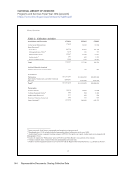14 Survey Results: Survey Questions and Responses
If yes, which data categories are gathered for collection assessment purposes? Check all that
apply. N=69
ACRL survey library collections data 50 73%
User satisfaction with the collections (e.g., LibQUAL+®) 47 68%
Open URL server statistics 27 39%
Use of materials that are not included in the library catalog (e.g., open access resources) 18 26%
Purpose of using digital resources (e.g., MINES for Libraries®) 11 16%
Other data 44 64%
Please specify the other data. N=44
Regularly N=28
Adequacy of collections to support new academic programs
Annual data calls by the institution on the collections, digitization, etc., which is used by the institution
for planning, reporting to Congress, etc.
Annual report, internal reporting
CEAL statistics, subject-area assessments
Collections information is required for university program and course reviews.
COUNTER reports, usage statistics for e-books and non-journal content
E-resource usage (primarily via Intota) print circulation data, including anonymized demographics
(school/department patron status) holdings/acquisitions data for partner libraries (on a project basis)
E-book and e-resource usage data, print circulation
E-journal and e-book usage data, transactional usage data for print collections
EZproxy, demand-driven acquisitions, ILS, budgets, circulation rates, weeding data (duplicates,
physical space). We also collect robust data (than reported on ARL or IPEDS) for reference and
instruction, collections, finance, digital library, and interlibrary loan.
Google Analytics, COUNTER compliant usage reports
ILL data on what our users borrow at the title level
ILL data, COUNTER compliant statistics on the use of e-resources (primarily JR1, BR2, and DB1)
ILL data, qualitative data (input from users), EZproxy logs, search logs on our discovery layer,
COUNTER stats, peer institution holdings, Scopus report on where researchers are editing and
publishing, e-resource turnaway stats.
ILL, overlap holdings with regional partners, COUNTER from e-providers
ILLIAD data, GWLA data, circulation patterns, collection data, collections spaces (physical and
virtual), IR, cost per use of e-resources
OCLC comparison analytics
On both a regular and project basis, monitor/assess changing nature of collections budget expenditures
gather data on cost, usage, and cost-per-use for e-journals and databases by specific resource and/or
publisher/vendor print book circulation statistics and subject-specific collections metrics (including
trend data) and university system mandated faculty and student satisfactions surveys
If yes, which data categories are gathered for collection assessment purposes? Check all that
apply. N=69
ACRL survey library collections data 50 73%
User satisfaction with the collections (e.g., LibQUAL+®) 47 68%
Open URL server statistics 27 39%
Use of materials that are not included in the library catalog (e.g., open access resources) 18 26%
Purpose of using digital resources (e.g., MINES for Libraries®) 11 16%
Other data 44 64%
Please specify the other data. N=44
Regularly N=28
Adequacy of collections to support new academic programs
Annual data calls by the institution on the collections, digitization, etc., which is used by the institution
for planning, reporting to Congress, etc.
Annual report, internal reporting
CEAL statistics, subject-area assessments
Collections information is required for university program and course reviews.
COUNTER reports, usage statistics for e-books and non-journal content
E-resource usage (primarily via Intota) print circulation data, including anonymized demographics
(school/department patron status) holdings/acquisitions data for partner libraries (on a project basis)
E-book and e-resource usage data, print circulation
E-journal and e-book usage data, transactional usage data for print collections
EZproxy, demand-driven acquisitions, ILS, budgets, circulation rates, weeding data (duplicates,
physical space). We also collect robust data (than reported on ARL or IPEDS) for reference and
instruction, collections, finance, digital library, and interlibrary loan.
Google Analytics, COUNTER compliant usage reports
ILL data on what our users borrow at the title level
ILL data, COUNTER compliant statistics on the use of e-resources (primarily JR1, BR2, and DB1)
ILL data, qualitative data (input from users), EZproxy logs, search logs on our discovery layer,
COUNTER stats, peer institution holdings, Scopus report on where researchers are editing and
publishing, e-resource turnaway stats.
ILL, overlap holdings with regional partners, COUNTER from e-providers
ILLIAD data, GWLA data, circulation patterns, collection data, collections spaces (physical and
virtual), IR, cost per use of e-resources
OCLC comparison analytics
On both a regular and project basis, monitor/assess changing nature of collections budget expenditures
gather data on cost, usage, and cost-per-use for e-journals and databases by specific resource and/or
publisher/vendor print book circulation statistics and subject-specific collections metrics (including
trend data) and university system mandated faculty and student satisfactions surveys




















































































































































































